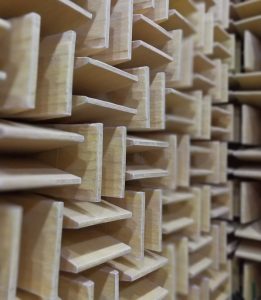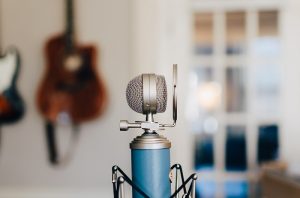Whether you’re married to a musician, raising one or are a musical master yourself, the noise of even a well-played instrument can impact your roommates, neighbors, or family. Even playing all the way across the house may not be far enough to muffle the sound, and things could be a lot worse if you’re in a small condo. There has to be a way to strike a balance between peace and quiet and the sound of music. Luckily, soundproofing a room — or even a few — can be a fairly simple DIY project to save not only your eardrums but also your sanity.
Not sure where to start? Not to worry! This how-to guide will give you three easy steps to soundproof your space. Plus, learn to transform a guest room into a home recording studio.
Soundproofing a Room in Three Easy Steps
Simple Soundproofing Step One: Mind the Gaps
Take a look around the room and keep an eye out for any gaps in door and window frames. A lot of sound can escape through even a small gap.
• Reduce door gaps: Adding a door sweep on both the inside and the outside of the door can help reduce sound travel.
• Cover the windows: You can hang thick curtains over windows, or seal leaks with budget-friendly foam weather stripping or professional-grade acoustical sealant.
• Line heating/cooling ducts: Don’t forget to line your heating and cooling ducts with soundproofing duct liner to further reduce noise.
Simple Soundproofing Step Two: Reduce Reflection
 Did you know that sound, like light, reflects? Sound can bounce off of any number of surfaces, which can propel the notes and beats of an instrument pretty far. If the room you’ve chosen as your practice area has any hard surfaces, like granite countertops, hardwood floors or even just plain old walls, sound will reverberate until it runs out of energy, which means it can hit multiple surfaces over and over again.
Did you know that sound, like light, reflects? Sound can bounce off of any number of surfaces, which can propel the notes and beats of an instrument pretty far. If the room you’ve chosen as your practice area has any hard surfaces, like granite countertops, hardwood floors or even just plain old walls, sound will reverberate until it runs out of energy, which means it can hit multiple surfaces over and over again.
How can you soundproof against reflection?
• Bring in some textiles! Cover the floor with carpeting or thick rugs, and even consider hanging some material from the walls.
• Install soundproof materials: There are all kinds of soundproofing materials out there, some more effective — and more costly — than others. You can install soundproof curtain around the perimeter of the room, tack up vinyl or install acoustic insulation.
• Avoid cheap alternatives: Considering a cheaper option like adding mattresses or egg crates to the walls? Skip them. Not only are they unsightly, but they are ineffective, as well.
Simple Soundproofing Step Three: Modify Your Space
Let’s say you live in a 1,000-square foot loft downtown and want to be sure your evening jam sessions don’t disrupt the neighbors. Being a good neighbor might mean you have to make some adjustments on your end.
• Avoid shared walls: Play your musical instruments in a room that doesn’t share any walls with your neighbors or position yourself closer to the outside walls.
• Add a false ceiling: You can consider adding a false ceiling to give some relief to the upstairs neighbors and replace your hollow doors with solid, heavy core ones. If you hit a major chord and notice some shaking picture frames, vases or other objects, remove them or secure them.
• Consider a shed or garage: If you live in a 2,000-square foot house and want to keep your drums from waking the baby, consider moving your equipment to the other side of the house, going out into the garage or renovating a tool shed in the backyard.
Setting Up a Simple Studio in a Small Space
Why settle for just playing around when you can really tap into your musical genius with a home studio? If you’re into composing, playing and recording, you might be ready to turn that unused guest room into a simple recording studio. Along with our other soundproofing tips, which will keep noise from escaping, you’ll also want to focus on acoustic treatment options so the music that stays in sounds the best. Single set-up studios can be simple and more cost-effective, but you’ll want to consider these tips and tricks for keeping your sound just right:
• Cancel feedback from electrical equipment by putting items like amps as far away from microphones as possible.
• Don’t completely eliminate all sound reflection: Leave a few spots open and treat them with diffusers so the natural frequency of your music isn’t lost.
• Think about high and low-end sound absorption: Most of your reflection treatments will tackle the high frequency reflections, but you’ll want to install a few bass traps in order to dampen the sound for lower frequencies.
• Plan for power: Be sure to have plenty of outlets, and make sure all of them are the right wattage for your equipment.
• Think seasonally: When the July high temperatures hit, will the sound of the air conditioning clicking on and blowing into your studio become background noise?
• Arrange it right: Even if you’re playing solo, be sure to arrange your studio to accommodate the number of musicians who could play at one time in the space. If you host other artists down the road, this will make it easier to plan out and arrange your recording stations to maximize the best sound for the number of people who will be there at once.
• Maximize your equipment: When dealing with small spaces, you also should examine how to maximize your equipment so that you have more room and fewer things for sound to bounce off of. It’s time to embrace the digital age! You can use digital instruments to keep the clutter to a minimum and, when appropriate and affordable, try using compact equipment.
Music is an incredible hobby for some, and a way of life for others. Not only will soundproofing your home help keep the peace in your family and with your neighbors, but it will also teach you some of the more scientific elements of sound and music that you may not experience just by playing an instrument. Whether to please your landlord or pacify your family, soundproofing can help you get more in touch with the instruments you love to play and the music you love to create.
Piano Lessons with Bojan Kolevski
We are blessed to have Bojan as an instructor at the JESM. We invite students from Wheaton, Carol Stream, Glen Ellyn, Lombard, Lisle, West Chicago, Naperville and the other suburbs of DuPage to contact us for their first lesson. Call us today at 630-359-7725 or email us at admin@jeschoolofmusic.com to schedule your first lesson.
















